毕业论文外文文献
- 格式:doc
- 大小:22.00 KB
- 文档页数:6
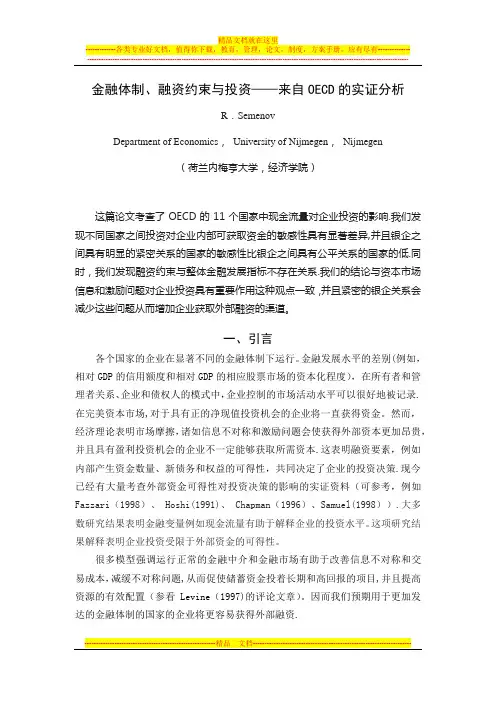
金融体制、融资约束与投资——来自OECD的实证分析R.SemenovDepartment of Economics,University of Nijmegen,Nijmegen(荷兰内梅亨大学,经济学院)这篇论文考查了OECD的11个国家中现金流量对企业投资的影响.我们发现不同国家之间投资对企业内部可获取资金的敏感性具有显著差异,并且银企之间具有明显的紧密关系的国家的敏感性比银企之间具有公平关系的国家的低.同时,我们发现融资约束与整体金融发展指标不存在关系.我们的结论与资本市场信息和激励问题对企业投资具有重要作用这种观点一致,并且紧密的银企关系会减少这些问题从而增加企业获取外部融资的渠道。
一、引言各个国家的企业在显著不同的金融体制下运行。
金融发展水平的差别(例如,相对GDP的信用额度和相对GDP的相应股票市场的资本化程度),在所有者和管理者关系、企业和债权人的模式中,企业控制的市场活动水平可以很好地被记录.在完美资本市场,对于具有正的净现值投资机会的企业将一直获得资金。
然而,经济理论表明市场摩擦,诸如信息不对称和激励问题会使获得外部资本更加昂贵,并且具有盈利投资机会的企业不一定能够获取所需资本.这表明融资要素,例如内部产生资金数量、新债务和权益的可得性,共同决定了企业的投资决策.现今已经有大量考查外部资金可得性对投资决策的影响的实证资料(可参考,例如Fazzari(1998)、 Hoshi(1991)、 Chapman(1996)、Samuel(1998)).大多数研究结果表明金融变量例如现金流量有助于解释企业的投资水平。
这项研究结果解释表明企业投资受限于外部资金的可得性。
很多模型强调运行正常的金融中介和金融市场有助于改善信息不对称和交易成本,减缓不对称问题,从而促使储蓄资金投着长期和高回报的项目,并且提高资源的有效配置(参看Levine(1997)的评论文章)。
因而我们预期用于更加发达的金融体制的国家的企业将更容易获得外部融资.几位学者已经指出建立企业和金融中介机构可进一步缓解金融市场摩擦。
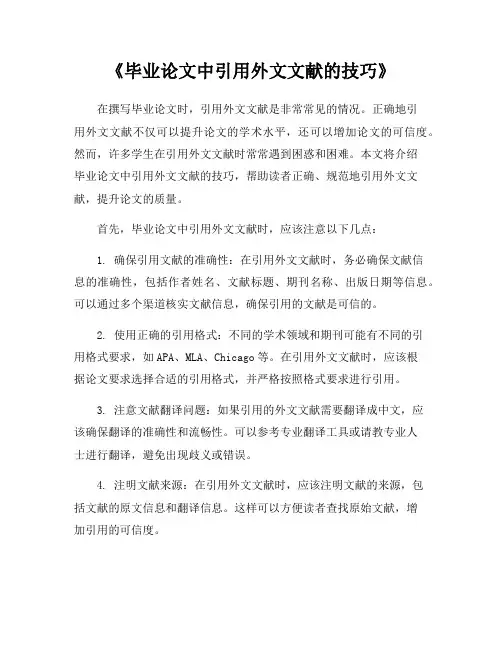
《毕业论文中引用外文文献的技巧》在撰写毕业论文时,引用外文文献是非常常见的情况。
正确地引用外文文献不仅可以提升论文的学术水平,还可以增加论文的可信度。
然而,许多学生在引用外文文献时常常遇到困惑和困难。
本文将介绍毕业论文中引用外文文献的技巧,帮助读者正确、规范地引用外文文献,提升论文的质量。
首先,毕业论文中引用外文文献时,应该注意以下几点:1. 确保引用文献的准确性:在引用外文文献时,务必确保文献信息的准确性,包括作者姓名、文献标题、期刊名称、出版日期等信息。
可以通过多个渠道核实文献信息,确保引用的文献是可信的。
2. 使用正确的引用格式:不同的学术领域和期刊可能有不同的引用格式要求,如APA、MLA、Chicago等。
在引用外文文献时,应该根据论文要求选择合适的引用格式,并严格按照格式要求进行引用。
3. 注意文献翻译问题:如果引用的外文文献需要翻译成中文,应该确保翻译的准确性和流畅性。
可以参考专业翻译工具或请教专业人士进行翻译,避免出现歧义或错误。
4. 注明文献来源:在引用外文文献时,应该注明文献的来源,包括文献的原文信息和翻译信息。
这样可以方便读者查找原始文献,增加引用的可信度。
5. 避免直译和抄袭:在引用外文文献时,应该避免直译和抄袭的情况。
可以适当进行文献内容的概括和改写,保持论文的原创性和学术性。
总之,正确地引用外文文献是撰写毕业论文的重要环节,需要认真对待。
通过遵循上述技巧,可以帮助读者规范引用外文文献,提升论文的学术水平和质量。
希望本文介绍的技巧对读者在毕业论文写作中有所帮助。
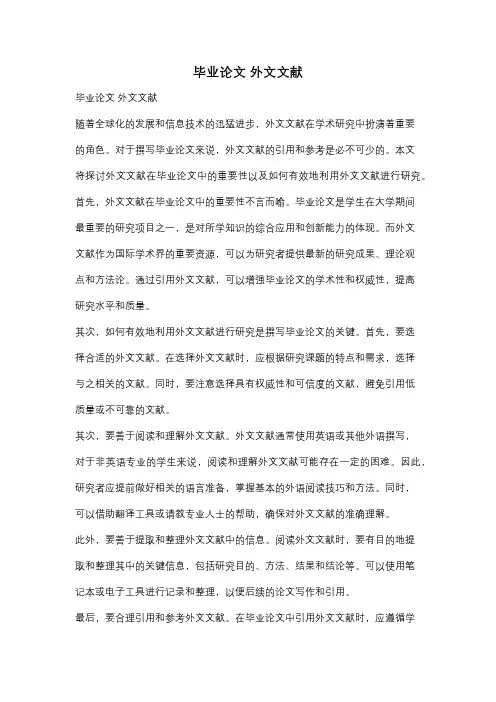
毕业论文外文文献毕业论文外文文献随着全球化的发展和信息技术的迅猛进步,外文文献在学术研究中扮演着重要的角色。
对于撰写毕业论文来说,外文文献的引用和参考是必不可少的。
本文将探讨外文文献在毕业论文中的重要性以及如何有效地利用外文文献进行研究。
首先,外文文献在毕业论文中的重要性不言而喻。
毕业论文是学生在大学期间最重要的研究项目之一,是对所学知识的综合应用和创新能力的体现。
而外文文献作为国际学术界的重要资源,可以为研究者提供最新的研究成果、理论观点和方法论。
通过引用外文文献,可以增强毕业论文的学术性和权威性,提高研究水平和质量。
其次,如何有效地利用外文文献进行研究是撰写毕业论文的关键。
首先,要选择合适的外文文献。
在选择外文文献时,应根据研究课题的特点和需求,选择与之相关的文献。
同时,要注意选择具有权威性和可信度的文献,避免引用低质量或不可靠的文献。
其次,要善于阅读和理解外文文献。
外文文献通常使用英语或其他外语撰写,对于非英语专业的学生来说,阅读和理解外文文献可能存在一定的困难。
因此,研究者应提前做好相关的语言准备,掌握基本的外语阅读技巧和方法。
同时,可以借助翻译工具或请教专业人士的帮助,确保对外文文献的准确理解。
此外,要善于提取和整理外文文献中的信息。
阅读外文文献时,要有目的地提取和整理其中的关键信息,包括研究目的、方法、结果和结论等。
可以使用笔记本或电子工具进行记录和整理,以便后续的论文写作和引用。
最后,要合理引用和参考外文文献。
在毕业论文中引用外文文献时,应遵循学术规范和引用格式的要求,确保引用的准确性和规范性。
同时,要注明引用文献的出处和作者,以避免抄袭和知识盗用的问题。
此外,还可以通过参考文献的引用,为自己的研究提供更多的支持和论证。
综上所述,外文文献在毕业论文中的重要性不可忽视。
通过合理利用外文文献,可以提高研究的深度和广度,增强论文的学术性和权威性。
因此,学生在撰写毕业论文时,应注重外文文献的引用和参考,善于利用外文文献进行研究,以提高论文的质量和水平。
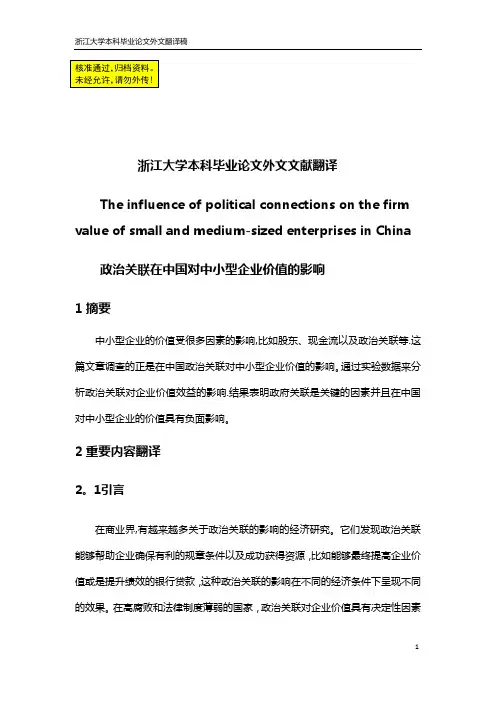
核准通过,归档资料。
未经允许,请勿外传!浙江大学本科毕业论文外文文献翻译The influence of political connections on the firm value of small and medium-sized enterprises in China政治关联在中国对中小型企业价值的影响1摘要中小型企业的价值受很多因素的影响,比如股东、现金流以及政治关联等.这篇文章调查的正是在中国政治关联对中小型企业价值的影响。
通过实验数据来分析政治关联对企业价值效益的影响.结果表明政府关联是关键的因素并且在中国对中小型企业的价值具有负面影响。
2重要内容翻译2。
1引言在商业界,有越来越多关于政治关联的影响的经济研究。
它们发现政治关联能够帮助企业确保有利的规章条件以及成功获得资源,比如能够最终提高企业价值或是提升绩效的银行贷款,这种政治关联的影响在不同的经济条件下呈现不同的效果。
在高腐败和法律制度薄弱的国家,政治关联对企业价值具有决定性因素1的作用.中国由高度集权的计划经济向市场经济转变,政府对市场具有较强的控制作用,而且有大量的上市企业具有政治关联。
中小型企业发展的很迅速,他们已经在全球经济环境中变得越来越重要。
从90年代起, 政治因素对中国的任何规模的企业来说都变得越来越重要,尤其是中小型企业的价值。
和其他的部门相比较,中小型企业只有较小的现金流,不稳定的现金流且高负债率.一方面,中小型企业改变更加灵活;另一方面,中小型企业在由于企业规模以及对银行来说没有可以抵押的资产,在筹资方面较为困难。
企业如何应对微观经济环境和政策去保证正常的企业活动,并且政治关联如何影响企业价值?这篇论文调查政治关联和企业价值之间的联系,并且试图去研究企业是否可以从政治关联中获利提升企业价值。
2.2定义这些中小型企业之所以叫中小型企业,是和管理规模有关。
对这些小企业来说,雇员很少,营业额较低,资金一般由较少的人提供,因此,通常由这些业主直接管理企业。
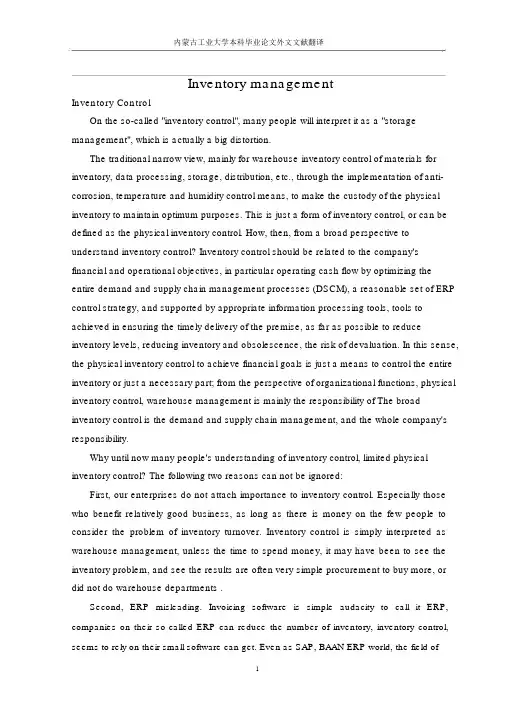
Inventory managementInventory ControlOn the so-called "inventory control", many people will interpret it as a "storage management", which is actually a big distortion.The traditional narrow view, mainly for warehouse inventory control of materials for inventory, data processing, storage, distribution, etc., through the implementation of anti-corrosion, temperature and humidity control means, to make the custody of the physical inventory to maintain optimum purposes. This is just a form of inventory control, or can be defined as the physical inventory control. How, then, from a broad perspective to understand inventory control? Inventory control should be related to the company's financial and operational objectives, in particular operating cash flow by optimizing the entire demand and supply chain management processes (DSCM), a reasonable set of ERP control strategy, and supported by appropriate information processing tools, tools to achieved in ensuring the timely delivery of the premise, as far as possible to reduce inventory levels, reducing inventory and obsolescence, the risk of devaluation. In this sense, the physical inventory control to achieve financial goals is just a means to control the entire inventory or just a necessary part; from the perspective of organizational functions, physical inventory control, warehouse management is mainly the responsibility of The broad inventory control is the demand and supply chain management, and the whole company's responsibility.Why until now many people's understanding of inventory control, limited physical inventory control? The following two reasons can not be ignored:First, our enterprises do not attach importance to inventory control. Especially those who benefit relatively good business, as long as there is money on the few people to consider the problem of inventory turnover. Inventory control is simply interpreted as warehouse management, unless the time to spend money, it may have been to see the inventory problem, and see the results are often very simple procurement to buy more, or did not do warehouse departments .Second, ERP misleading. Invoicing software is simple audacity to call it ERP, companies on their so-called ERP can reduce the number of inventory, inventory control, seems to rely on their small software can get. Even as SAP, BAAN ERP world, the field ofthese big boys, but also their simple modules inside the warehouse management functionality is defined as "inventory management" or "inventory control." This makes the already not quite understand what our inventory control, but not sure what is inventory control.In fact, from the perspective of broadly understood, inventory control, shouldinclude the following:First, the fundamental purpose of inventory control. We know that the so-called world-class manufacturing, two key assessment indicators (KPI) is, customer satisfaction and inventory turns, inventory turns and this is actually the fundamental objective of inventory control.Second, inventory control means. Increase inventory turns, relying solely on the so-called physical inventory control is not enough, it should be the demand and supply chain management process flow of this large output, and this big warehouse management processes in addition to including this link, the more important The section also includes: forecasting and order processing, production planning and control, materials planning and purchasing control, inventory planning and forecasting in itself, as well as finished products, raw materials, distribution and delivery of the strategy, and even customs management processes.And with the demand and supply chain management processes throughout the process, it is the information flow and capital flow management. In other words, inventory itself is across the entire demand and supply management processes in all aspects of inventory control in order to achieve the fundamental purpose, it must control all aspects of inventory, rather than just manage the physical inventory at hand.Third, inventory control, organizational structure and assessment.Since inventory control is the demand and supply chain management processes, output, inventory control to achieve the fundamental purpose of this process must be compatible with a rational organizational structure. Until now, we can see that many companies have only one purchasing department, purchasing department following pipe warehouse. This is far short of inventory control requirements. From the demand and supply chain management process analysis, we know that purchasing and warehouse management is the executive arm of the typical, and inventory control should focus on prevention, the executive branch is very difficult to "prevent inventory" for the simple reason that they assessment indicatorsin large part to ensure supply (production, customer). How the actual situation, a reasonable demand and supply chain management processes, and thus set the corresponding rational organizational structure and is a question many of our enterprisesto exploreThe role of inventory controlInventory management is an important part of business management. In the production and operation activities, inventory management must ensure that both the production plant for raw materials, spare parts demand, but also directly affect the purchasing, sales of share, sales activities. To make an inventory of corporate liquidity, accelerate cash flow, the security of supply under the premise of minimizing Yaku funds, directly affects the operational efficiency. Ensure the production and operation needs of the premise, so keep inventories at a reasonable level; dynamic inventory control, timely, appropriate proposed order to avoid over storage or out of stock; reduce inventory footprint, lower total cost of inventory; control stock funds used to accelerate cash flow.Problems arising from excessive inventory: increased warehouse space andinventory storage costs, thereby increasing product costs; take a lot of liquidity, resultingin sluggish capital, not only increased the burden of payment of interest, etc., would affect the time value of money and opportunity income; finished products and raw materials caused by physical loss and intangible losses; a large number of enterprise resource idle, affecting their rational allocation and optimization; cover the production, operation of the whole process of the various contradictions and problems, is not conducive to improve the management level.Inventory is too small the resulting problems: service levels caused a decline in the profit impact of marketing and corporate reputation; production system caused by inadequate supply of raw materials or other materials, affecting the normal production process; to shorten lead times, increase the number of orders, so order (production) costs; affect the balance of production and assembly of complete sets.NotesInventory management should particularly consider the following two questions:First, according to sales plans, according to the planned production of the goods circulated in the market, we should consider where, how much storage.Second, starting from the level of service and economic benefits to determine howto ensure inventories and supplementary questions.The two problems with the inventory in the logistics process functions.In general, the inventory function:(1)to prevent interrupted. Received orders to shorten the delivery of goods fromthe time in order to ensure quality service, at the same time to prevent out of stock.(2)to ensure proper inventory levels, saving inventory costs.(3)to reduce logistics costs. Supplement with the appropriate time interval compatible with the reasonable demand of the cargo in order to reduce logistics costs, eliminate or avoid sales fluctuations.(4)ensure the production planning, smooth to eliminate or avoid sales fluctuations.(5)display function.(6)reserve. Mass storage when the price falls, reduce losses, to respond to disasters and other contingencies.About the warehouse (inventory) on what the question, we must consider the number and location. If the distribution center, it should be possible according to customer needs, set at an appropriate place; if it is stored in central places to minimize the complementary principle to the distribution centers, there is no place certain requirements. When the stock base is established, will have to take into account are stored in various locations in what commodities.库存管理库存控制在谈到所谓“库存控制”的时候,很多人将其理解为“仓储管理”,这实际上是个很大的曲解。
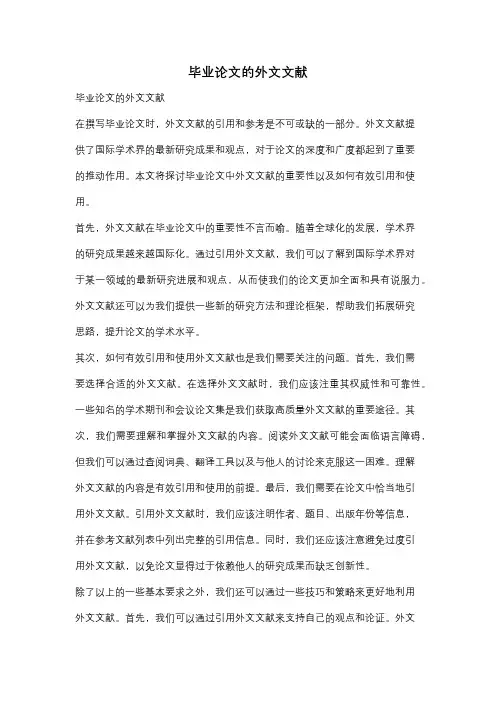
毕业论文的外文文献毕业论文的外文文献在撰写毕业论文时,外文文献的引用和参考是不可或缺的一部分。
外文文献提供了国际学术界的最新研究成果和观点,对于论文的深度和广度都起到了重要的推动作用。
本文将探讨毕业论文中外文文献的重要性以及如何有效引用和使用。
首先,外文文献在毕业论文中的重要性不言而喻。
随着全球化的发展,学术界的研究成果越来越国际化。
通过引用外文文献,我们可以了解到国际学术界对于某一领域的最新研究进展和观点,从而使我们的论文更加全面和具有说服力。
外文文献还可以为我们提供一些新的研究方法和理论框架,帮助我们拓展研究思路,提升论文的学术水平。
其次,如何有效引用和使用外文文献也是我们需要关注的问题。
首先,我们需要选择合适的外文文献。
在选择外文文献时,我们应该注重其权威性和可靠性。
一些知名的学术期刊和会议论文集是我们获取高质量外文文献的重要途径。
其次,我们需要理解和掌握外文文献的内容。
阅读外文文献可能会面临语言障碍,但我们可以通过查阅词典、翻译工具以及与他人的讨论来克服这一困难。
理解外文文献的内容是有效引用和使用的前提。
最后,我们需要在论文中恰当地引用外文文献。
引用外文文献时,我们应该注明作者、题目、出版年份等信息,并在参考文献列表中列出完整的引用信息。
同时,我们还应该注意避免过度引用外文文献,以免论文显得过于依赖他人的研究成果而缺乏创新性。
除了以上的一些基本要求之外,我们还可以通过一些技巧和策略来更好地利用外文文献。
首先,我们可以通过引用外文文献来支持自己的观点和论证。
外文文献往往能够提供更多的证据和数据,从而增强我们的论点的可信度。
其次,我们可以通过对比和分析多个外文文献的观点来得出自己的结论。
不同的学者和研究者可能对同一个问题有不同的看法和解释,我们可以通过比较和综合不同的观点来得出自己的独立见解。
此外,我们还可以通过对外文文献的引用来扩大论文的国际影响力。
一些知名的外文文献的引用可以为我们的论文增加学术声望和影响力,提升我们的研究的知名度。
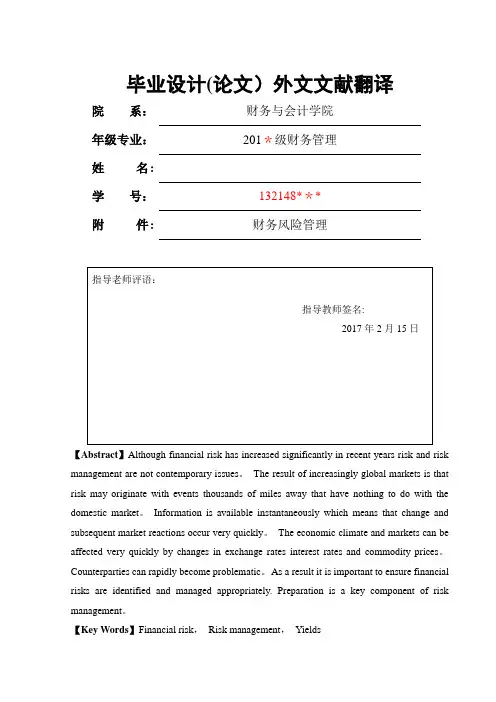
毕业设计(论文)外文文献翻译院系:财务与会计学院年级专业:201*级财务管理姓名:学号:132148***附件: 财务风险管理【Abstract】Although financial risk has increased significantly in recent years risk and risk management are not contemporary issues。
The result of increasingly global markets is that risk may originate with events thousands of miles away that have nothing to do with the domestic market。
Information is available instantaneously which means that change and subsequent market reactions occur very quickly。
The economic climate and markets can be affected very quickly by changes in exchange rates interest rates and commodity prices。
Counterparties can rapidly become problematic。
As a result it is important to ensure financial risks are identified and managed appropriately. Preparation is a key component of risk management。
【Key Words】Financial risk,Risk management,YieldsI. Financial risks arising1.1What Is Risk1.1.1The concept of riskRisk provides the basis for opportunity. The terms risk and exposure have subtle differences in their meaning. Risk refers to the probability of loss while exposure is the possibility of loss although they are often used interchangeably。
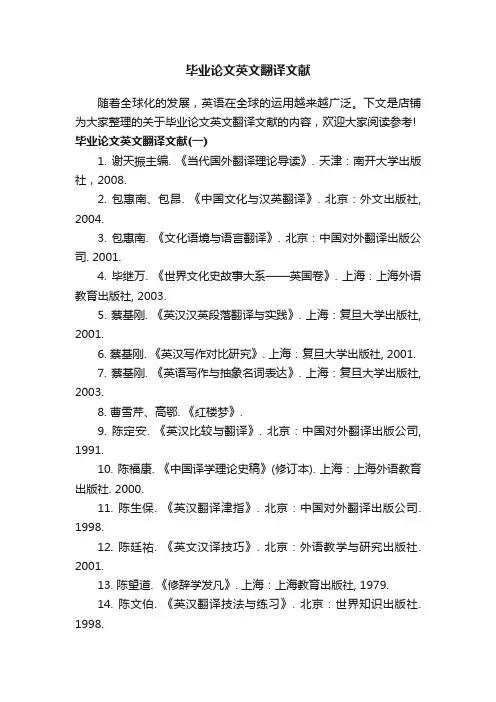
毕业论文英文翻译文献随着全球化的发展,英语在全球的运用越来越广泛。
下文是店铺为大家整理的关于毕业论文英文翻译文献的内容,欢迎大家阅读参考! 毕业论文英文翻译文献(一)1. 谢天振主编. 《当代国外翻译理论导读》. 天津:南开大学出版社,2008.2. 包惠南、包昂. 《中国文化与汉英翻译》. 北京:外文出版社, 2004.3. 包惠南. 《文化语境与语言翻译》. 北京:中国对外翻译出版公司. 2001.4. 毕继万. 《世界文化史故事大系——英国卷》. 上海:上海外语教育出版社, 2003.5. 蔡基刚. 《英汉汉英段落翻译与实践》. 上海:复旦大学出版社, 2001.6. 蔡基刚. 《英汉写作对比研究》. 上海:复旦大学出版社, 2001.7. 蔡基刚. 《英语写作与抽象名词表达》. 上海:复旦大学出版社, 2003.8. 曹雪芹、高鄂. 《红楼梦》.9. 陈定安. 《英汉比较与翻译》. 北京:中国对外翻译出版公司, 1991.10. 陈福康. 《中国译学理论史稿》(修订本). 上海:上海外语教育出版社. 2000.11. 陈生保. 《英汉翻译津指》. 北京:中国对外翻译出版公司. 1998.12. 陈廷祐. 《英文汉译技巧》. 北京:外语教学与研究出版社. 2001.13. 陈望道. 《修辞学发凡》. 上海:上海教育出版社, 1979.14. 陈文伯. 《英汉翻译技法与练习》. 北京:世界知识出版社. 1998.15. 陈中绳、吴娟. 《英汉新词新义佳译》. 上海:上海翻译出版公司. 1990.16. 陈忠诚. 《词语翻译丛谈》. 北京:中国对外翻译出版公司, 1983.17. 程希岚. 《修辞学新编》. 吉林:吉林人民出版社, 1984.18. 程镇球. 《翻译论文集》. 北京:外语教学与研究出版社. 2002.19. 程镇球. 《翻译问题探索》. 北京:商务印书馆, 1980.20. 崔刚. 《广告英语》. 北京:北京理工大学出版社, 1993.21. 单其昌. 《汉英翻译技巧》. 北京:外语教学与研究出版社. 1990.22. 单其昌. 《汉英翻译讲评》. 北京:对外贸易教育出版社. 1989.23. 邓炎昌、刘润清. 《语言与文化——英汉语言文化对比》. 北京:外语教学与研究出版社, 1989.24. 丁树德. 《英汉汉英翻译教学综合指导》. 天津:天津大学出版社, 1996.25. 杜承南等,《中国当代翻译百论》. 重庆:重庆大学出版社, 1994.26. 《翻译通讯》编辑部. 《翻译研究论文集(1894-1948)》. 北京:外语教学与研究出版社. 1984.27. 《翻译通讯》编辑部. 《翻译研究论文集(1949-1983)》. 北京:外语教学与研究出版社. 1984. .28. 范勇主编. 《新编汉英翻译教程》. 天津:南开大学出版社. 2006.29. 方梦之、马秉义(编选). 《汉译英实践与技巧》. 北京:旅游教育出版社. 1996.30. 方梦之. 《英语汉译实践与技巧》. 天津:天津科技翻译出版公司. 1994.31. 方梦之主编. 《译学辞典》. 上海:上海外语教育出版社. 2004.32. 冯翠华. 《英语修辞大全》,北京:外语教学与研究出版社, 1995.33. 冯庆华. 《文体与翻译》. 上海:上海外语教育出版社, 2002.34. 冯庆华主编. 《文体翻译论》. 上海:上海外语教育出版社. 2002.35. 冯胜利. 《汉语的韵律、词法与句法》. 北京:北京大学出版社, 1997.36. 冯志杰. 《汉英科技翻译指要》. 北京:中国对外翻译出版公司. 1998.37. 耿占春. 《隐喻》. 北京:东方出版社, 1993.38. 郭建中. 《当代美国翻译理论》. 武汉:湖北教育出版社. 2000.39. 郭建中. 《文化与翻译》. 北京:中国对外翻译出版公司. 2000.40. 何炳威. 《容易误译的英语》. 北京:外语教学与研究出版社. 2002.41. 何刚强. 《现代英汉翻译操作》. 北京:北京大学出版社. 1998.42. 何刚强. 《现代英语表达与汉语对应》. 上海:复旦大学出版社. 1994.43. 何刚强. 《英汉口笔译技艺》. 上海:复旦大学出版社, 2003. 毕业论文英文翻译文献(二)1. 何自然、张达三、杨伟钧等译. 《现代英语语法教程》. 北京:商务印书馆, 1990.2. 何自然. 《语用学概论》. 长沙: 湖南教育出版社, 1988.3. 侯维瑞. 《英语语体》. 上海:上海外语教育出版社, 1988.4. 胡庚申. 《怎样起草与翻译合同协议》. 合肥:中国科技大学出版社, 1993.5. 胡曙中. 《英汉修辞比较研究》. 上海:上海外语教育出版社, 1993.6. 胡晓吉. 《实用英汉对比翻译》. 北京:中国人民大学出版社. 1990.7. 胡燕平,张容建. 《实用英汉翻译类典》. 重庆:重庆出版社, 1997.8. 胡裕树. 《现代汉语》. 上海:上海教育出版社, 1987.9. 胡兆云. 《美学理论视野中的文学翻译研究》(第2版). 北京:现代教育出版社. 2009.10. 胡兆云. 《语言接触与英汉借词研究》. 济南:山东大学出版社. 2001.11. 胡壮麟. 《语篇的衔接与连贯》. 上海:上海外语教育出版社, 1994.12. 胡壮麟. 《语言学教程》. 北京:北京大学出版社, 1988.13. 黄伯荣, 廖序东. 《现代汉语》. 兰州:甘肃人民出版社, 1981.14. 黄国文. 《语篇分析概要》. 长沙:湖南教育出版社, 1988.15. 黄龙. 《翻译技巧指导》. 沈阳:辽宁人民出版社, 1986.16. 黄任. 《英语修辞与写作》. 上海:上海外语教育出版社, 1996.17. 黄雨石. 《英汉文学翻译探索》. 西安:陕西人民出版社. 1988.18. 黄振定. 《翻译学:艺术论与科学论的统一》. 长沙:湖南教育出版社. 1998.19. 黄振定. 《翻译学的语言哲学基础》. 上海:上海交通大学出版社. 2007.20. 黄忠廉. 《变译理论》. 北京:中国对外翻译出版公司. 2002.21. 贾尔斯英译. 《孙子兵法》. 长沙:湖南出版社, 1993.22. 贾文波. 《汉英时文翻译: 政治经济汉译英300句析》. 北京:中国对外翻译出版公司, 1999.23. 贾玉新. 《跨文化交际学》. 上海:上海外语教育出版社, 1997.24. 金隄. 《等效翻译探索》. 北京:中国对外翻译出版公司. 1998.25. 金惠康. 《汉英跨文化交际翻译》. 贵阳:贵州教育出版社. 1998.26. 金惠康. 《跨文华交际翻译》. 北京:中国对外翻译出版公司, 2003.27. 金惠康. 《跨文华交际翻译续编》. 北京:中国对外翻译出版公司, 2004.28. 金立鑫. 《语法的多视角研究》. 上海:上海外语教育出版社, 2000.29. 居祖纯. 《新编汉英语篇翻译》. 北京:清华大学出版社, 2002.30. 柯平. 《对比语言学》. 南京:南京师范大学出版社, 1999.31. 孔慧怡. 《翻译·文学·文化》. 北京:北京大学出版社. 1999.32. 李定坤. 《汉英辞格对比与翻译》. 武汉:华中师范大学出版社, 1994.33. 李国南. 《辞格与词汇》. 上海:上海外语教育出版社, 2002.34. 李国南. 《英汉修辞格对比研究》. 福州:福建人民出版社, 1999.35. 李明编著. 《英汉互动翻译教程》. 武汉:武汉大学出版社. 2006.36. 李瑞华(主编). 《英汉语言文化对比研究》. 上海:上海外语教育出版社. 1996.。
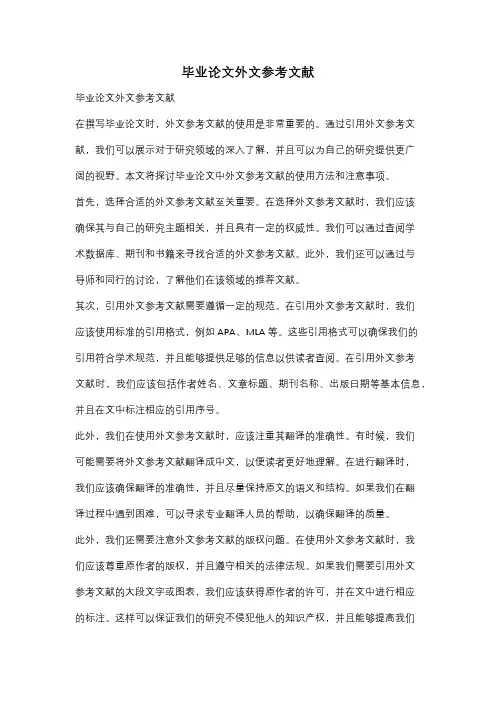
毕业论文外文参考文献毕业论文外文参考文献在撰写毕业论文时,外文参考文献的使用是非常重要的。
通过引用外文参考文献,我们可以展示对于研究领域的深入了解,并且可以为自己的研究提供更广阔的视野。
本文将探讨毕业论文中外文参考文献的使用方法和注意事项。
首先,选择合适的外文参考文献至关重要。
在选择外文参考文献时,我们应该确保其与自己的研究主题相关,并且具有一定的权威性。
我们可以通过查阅学术数据库、期刊和书籍来寻找合适的外文参考文献。
此外,我们还可以通过与导师和同行的讨论,了解他们在该领域的推荐文献。
其次,引用外文参考文献需要遵循一定的规范。
在引用外文参考文献时,我们应该使用标准的引用格式,例如APA、MLA等。
这些引用格式可以确保我们的引用符合学术规范,并且能够提供足够的信息以供读者查阅。
在引用外文参考文献时,我们应该包括作者姓名、文章标题、期刊名称、出版日期等基本信息,并且在文中标注相应的引用序号。
此外,我们在使用外文参考文献时,应该注重其翻译的准确性。
有时候,我们可能需要将外文参考文献翻译成中文,以便读者更好地理解。
在进行翻译时,我们应该确保翻译的准确性,并且尽量保持原文的语义和结构。
如果我们在翻译过程中遇到困难,可以寻求专业翻译人员的帮助,以确保翻译的质量。
此外,我们还需要注意外文参考文献的版权问题。
在使用外文参考文献时,我们应该尊重原作者的版权,并且遵守相关的法律法规。
如果我们需要引用外文参考文献的大段文字或图表,我们应该获得原作者的许可,并在文中进行相应的标注。
这样可以保证我们的研究不侵犯他人的知识产权,并且能够提高我们的学术声誉。
最后,我们还应该注意外文参考文献的可信度。
在使用外文参考文献时,我们应该确保其来源可靠,并且经过了同行评审。
我们可以通过查看期刊的影响因子、作者的学术背景和引用次数等指标来评估外文参考文献的可信度。
此外,我们还可以通过查阅其他相关研究的引用文献,来了解该外文参考文献在该领域的重要性和影响力。
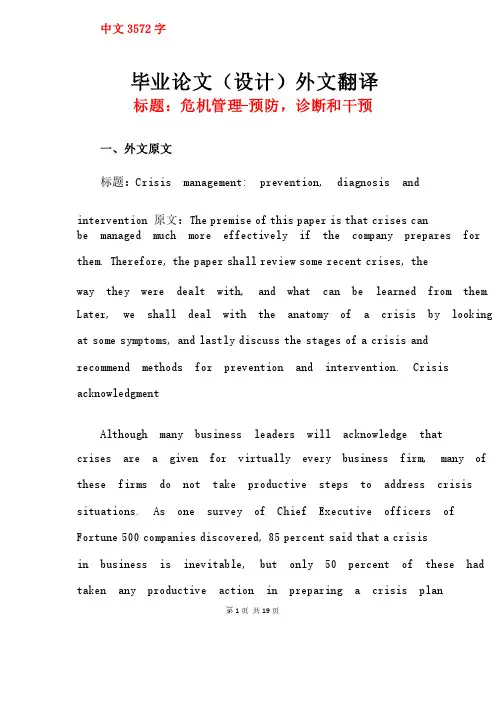
第1页 共19页中文3572字毕业论文(设计)外文翻译标题:危机管理-预防,诊断和干预一、外文原文标题:标题:Crisis management: prevention, diagnosis and Crisis management: prevention, diagnosis andintervention 原文:原文:The Thepremise of this paper is that crises can be managed much more effectively if the company prepares for them. Therefore, the paper shall review some recent crises, theway they were dealt with, and what can be learned from them. Later, we shall deal with the anatomy of a crisis by looking at some symptoms, and lastly discuss the stages of a crisis andrecommend methods for prevention and intervention. Crisis acknowledgmentAlthough many business leaders will acknowledge thatcrises are a given for virtually every business firm, many of these firms do not take productive steps to address crisis situations. As one survey of Chief Executive officers of Fortune 500 companies discovered, 85 percent said that a crisisin business is inevitable, but only 50 percent of these had taken any productive action in preparing a crisis plan(Augustine, 1995). Companies generally go to great lengths to plan their financial growth and success. But when it comes to crisis management, they often fail to think and prepare for those eventualities that may lead to a company’s total failure.Safety violations, plants in need of repairs, union contracts, management succession, and choosing a brand name, etc. can become crises for which many companies fail to be prepared untilit is too late.The tendency, in general, is to look at the company as a perpetual entity that requires plans for growth. Ignoring the probabilities of disaster is not going to eliminate or delay their occurrences. Strategic planning without inclusion ofcrisis management is like sustaining life without guaranteeinglife. One reason so many companies fail to take steps to proactively plan for crisis events, is that they fail to acknowledge the possibility of a disaster occurring. Like an ostrich with its head in the sand, they simply choose to ignorethe situation, with the hope that by not talking about it, it will not come to pass. Hal Walker, a management consultant, points out “that decisions will be more rational and better received, and the crisis will be of shorter duration, forcompanies who prepare a proactive crisis plan” (Maynard, 1993) .It is said that “there are two kinds of crises: those that thatyou manage, and those that manage you” (Augustine, 1995). Proactive planning helps managers to control and resolve a crisis. Ignoring the possibility of a crisis, on the other hand,could lead to the crisis taking a life of its own. In 1979, theThree-Mile Island nuclear power plant experienced a crisis whenwarning signals indicated nuclear reactors were at risk of a meltdown. The system was equipped with a hundred or more different alarms and they all went off. But for those who shouldhave taken the necessary steps to resolve the situation, therewere no planned instructions as to what should be done first. Hence, the crisis was not acknowledged in the beginning and itbecame a chronic event.In June 1997, Nike faced a crisis for which they had no existi existing frame of reference. A new design on the company’s ng frame of reference. A new design on the company’s Summer Hoop line of basketball shoes - with the word air writtenin flaming letters - had sparked a protest by Muslims, who complained the logo resembled the Arabic word for Allah, or God.The council of American-Islamic Relations threatened aa globalNike boycott. Nike apologized, recalled 38,000 pairs of shoes,and discontinued the line (Brindley, 1997). To create the brand,Nike had spent a considerable amount of time and money, but hadnever put together a general framework or policy to deal with such controversies. To their dismay, and financial loss, Nike officials had no choice but to react to the crisis. This incident has definitely signaled to the company that spending a little more time would have prevented the crisis. Nonetheless,it has taught the company a lesson in strategic crisis management planning.In a business organization, symptoms or signals can alert the strategic planners or executives of an eminent crisis. Slipping market share, losing strategic synergy anddiminishing productivity per man hour, as well as trends, issues and developments in the socio-economic, political and competitive environments, can signal crises, the effects of which can be very detrimental. After all, business failures and bankruptcies are not intended. They do not usually happen overnight. They occur more because of the lack of attention to symptoms than any other factor.Stages of a crisisMost crises do not occur suddenly. The signals can usuallybe picked up and the symptoms checked as they emerge. A company determined to address these issues realizes that the real challenge is not just to recognize crises, but to recognize themin a timely fashion (Darling et al., 1996). A crisis can consistof four different and distinct stages (Fink, 1986). The phasesare: prodromal crisis stage, acute crisis stage, chronic crisisstage and crisis resolution stage.Modern organizations are often called “organic” due tothe fact that they are not immune from the elements of their surrounding environments. Very much like a living organism, organizations can be affected by environmental factors both positively and negatively. But today’s successfulorganizations are characterized by the ability to adapt by recognizing important environmental factors, analyzing them, evaluating the impacts and reacting to them. The art of strategic planning (as it relates to crisis management)involves all of the above activities. The right strategy, in general, provides for preventive measures, and treatment or resolution efforts both proactively and reactively. It wouldbe quite appropriate to examine the first three stages of acrisis before taking up the treatment, resolution or intervention stage.Prodromal crisis stageIn the field of medicine, a prodrome is a symptom of the onset of a disease. It gives a warning signal. In business organizations, the warning lights are always blinking. No matter how successful the organization, a number of issues andtrends may concern the business if proper and timely attentionis paid to them. For example, in 1995, Baring Bank, a UK financial institution which had been in existence since 1763,ample opportunitysuddenly and unexpectedly failed. There wasfor the bank to catch the signals that something bad was on thehorizon, but the company’s efforts to detect that were thwarted by an internal structure that allowed a single employee both to conduct and to oversee his own investment trades, and the breakdown of management oversight and internalcontrol systems (Mitroff et al., 1996). Likewise, looking in retrospect, McDonald’s fast food chain was given the prodromalsymptoms before the elderly lady sued them for the spilling ofa very hot cup of coffee on her lap - an event that resulted in a substantial financial loss and tarnished image of thecompany. Numerous consumers had complained about thetemperature of the coffee. The warning light was on, but the company did not pay attention. It would have been much simplerto pick up the signal, or to check the symptom, than facing the consequences.In another case, Jack in the Box, a fast food chain, had several customers suffer intestinal distress after eating at their restaurants. The prodromal symptom was there, but the company took evasive action. Their initial approach was to lookaround for someone to blame. The lack of attention, the evasiveness and the carelessness angered all the constituent groups, including their customers. The unfortunate deaths thatptoms,occurred as a result of the company’s ignoring thesymand the financial losses that followed, caused the company to realize that it would have been easier to manage the crisis directly in the prodromal stage rather than trying to shift theblame.Acute crisis stageA prodromal stage may be oblique and hard to detect. The examples given above, are obvious prodromal, but no action wasWebster’s New Collegiate Dictionary, an acute stage occursacutewhen a symptom “demands urgent attention.” Whether the acutesymptom emerges suddenly or is a transformation of a prodromalstage, an immediate action is required. Diverting funds and other resources to this emerging situation may cause disequilibrium and disturbance in the whole system. It is onlythose organizations that have already prepared a framework forthese crises that can sustain their normal operations. For example, the US public roads and bridges have for a long time reflected a prodromal stage of crisis awareness by showing cracks and occasionally a collapse. It is perhaps in light of the obsessive decision to balance the Federal budget that reacting to the problem has been delayed and ignored. This situation has entered an acute stage and at the time of this writing, it was reported that a bridge in Maryland had just collapsed.The reason why prodromes are so important to catch is thatit is much easier to manage a crisis in this stage. In the caseof most crises, it is much easier and more reliable to take careof the problem before it becomes acute, before it erupts and causes possible complications (Darling et al., 1996). In andamage. However, the losses are incurred. Intel, the largest producer of computer chips in the USA, had to pay an expensiveprice for initially refusing to recall computer chips that proved unreliable o n on certain calculations. The f irmfirm attempted to play the issue down and later learned its lesson. At an acutestage, when accusations were made that the Pentium Chips were not as fast as they claimed, Intel quickly admitted the problem,apologized for it, and set about fixing it (Mitroff et al., 1996). Chronic crisis stageDuring this stage, the symptoms are quite evident and always present. I t isIt is a period of “make or break.” Being the third stage, chronic problems may prompt the company’s management to once and for all do something about the situation. It may be the beginning of recovery for some firms, and a deathknell for others. For example, the Chrysler Corporation was only marginallysuccessful throughout the 1970s. It was not, however, until the company was nearly bankrupt that amanagement shake-out occurred. The drawback at the chronic stage is that, like in a human patient, the company may get used to “quick fixes” and “band “band--aid”approaches. After all, the ailment, the problem and the crisis have become an integral partoverwhelmed by prodromal and acute problems that no time or attention is paid to the chronic problems, or the managers perceive the situation to be tolerable, thus putting the crisison a back burner.Crisis resolutionCrises could be detected at various stages of their development. Since the existing symptoms may be related todifferent problems or crises, there is a great possibility thatthey may be misinterpreted. Therefore, the people in charge maybelieve they have resolved the problem. However, in practicethe symptom is often neglected. In such situations, the symptomwill offer another chance for resolution when it becomes acute,thereby demanding urgent care. Studies indicate that today anincreasing number of companies are issue-oriented and searchfor symptoms. Nevertheless, the lack of experience in resolvinga situation and/or inappropriate handling of a crisis can leadto a chronic stage. Of course, there is this last opportunityto resolve the crisis at the chronic stage. No attempt to resolve the crisis, or improper resolution, can lead to grim consequences that will ultimately plague the organization or even destroy it.It must be noted that an unsolved crisis may not destroy the company. But, its weakening effects can ripple through the organization and create a host of other complications.Preventive effortsThe heart of the resolution of a crisis is in the preventiveefforts the company has initiated. This step, similar to a humanbody, is actually the least expensive, but quite often the mostoverlooked. Preventive measures deal with sensing potential problems (Gonzales-Herrero and Pratt, 1995). Major internalfunctions of a company such as finance, production, procurement, operations, marketing and human resources are sensitive to thesocio-economic, political-legal, competitive, technological, demographic, global and ethical factors of the external environment. What is imminently more sensible and much more manageable, is to identify the processes necessary forassessing and dealing with future crises as they arise (Jacksonand Schantz, 1993). At the core of this process are appropriate information systems, planning procedures, anddecision-making techniques. A soundly-based information system will scan the environment, gather appropriate data, interpret this data into opportunities and challenges, and provide a concretefoundation for strategies that could function as much to avoid crises as to intervene and resolve them.Preventive efforts, as stated before, require preparations before any crisis symptoms set in. Generally strategic forecasting, contingency planning, issues analysis, and scenario analysis help to provide a framework that could be used in avoiding and encountering crises.出处:出处:Toby TobyJ. Kash and John R. Darling . Crisis management: prevention, diagnosis 179-186二、翻译文章标题:危机管理:预防,诊断和干预译文:本文的前提是,如果该公司做好准备得话,危机可以更有效地进行管理。
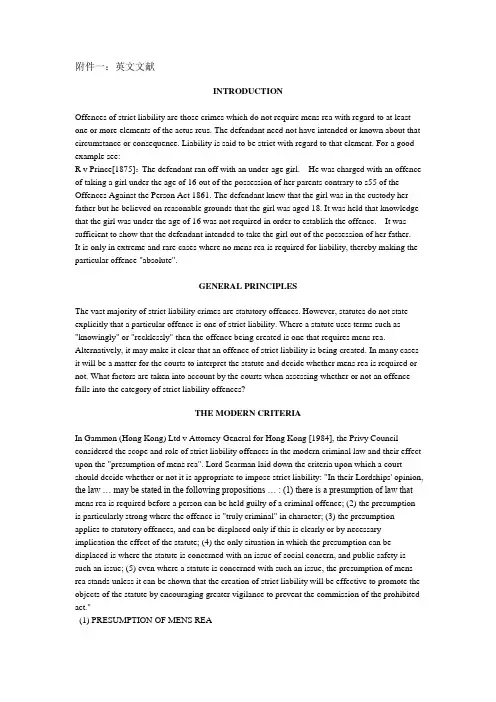
附件一:英文文献INTRODUCTIONOffences of strict liability are those crimes which do not require mens rea with regard to at least one or more elements of the actus reus. The defendant need not have intended or known about that circumstance or consequence. Liability is said to be strict with regard to that element. For a good example see:R v Prince[1875]:The defendant ran off with an under-age girl. He was charged with an offence of taking a girl under the age of 16 out of the possession of her parents contrary to s55 of the Offences Against the Person Act 1861. The defendant knew that the girl was in the custody her father but he believed on reasonable grounds that the girl was aged 18. It was held that knowledge that the girl was under the age of 16 was not required in order to establish the offence. It was sufficient to show that the defendant intended to take the girl out of the possession of her father.It is only in extreme and rare cases where no mens rea is required for liability, thereby making the particular offence "absolute".GENERAL PRINCIPLESThe vast majority of strict liability crimes are statutory offences. However, statutes do not state explicitly that a particular offence is one of strict liability. Where a statute uses terms such as "knowingly" or "recklessly" then the offence being created is one that requires mens rea. Alternatively, it may make it clear that an offence of strict liability is being created. In many cases it will be a matter for the courts to interpret the statute and decide whether mens rea is required or not. What factors are taken into account by the courts when assessing whether or not an offence falls into the category of strict liability offences?THE MODERN CRITERIAIn Gammon (Hong Kong) Ltd v Attorney-General for Hong Kong [1984], the Privy Council considered the scope and role of strict liability offences in the modern criminal law and their effect upon the "presumption of mens rea". Lord Scarman laid down the criteria upon which a court should decide whether or not it is appropriate to impose strict liability: "In their Lordships' opinion, the law … may be stated in the following propositions … : (1) there is a presumption of law that mens rea is required before a person can be held guilty of a criminal offence; (2) the presumption is particularly strong where the offence is "truly criminal" in character; (3) the presumption applies to statutory offences, and can be displaced only if this is clearly or by necessary implication the effect of the statute; (4) the only situation in which the presumption can be displaced is where the statute is concerned with an issue of social concern, and public safety is such an issue; (5) even where a statute is concerned with such an issue, the presumption of mens rea stands unless it can be shown that the creation of strict liability will be effective to promote the objects of the statute by encouraging greater vigilance to prevent the commission of the prohibited act."(1) PRESUMPTION OF MENS REACourts usually begin with the presumption in favor of mens rea, seeing the well-known statement by Wright J in Sherras v De Rutzen:There is a presumption that mens rea, or evil intention, or knowledge of the wrongfulness of the act, is an essential ingredient in every offence; but that presumption is liable to be displaced either by the words of the statute creating the offence or by the subject-matter with which it deals, and both must be considered(2) GRAVITY OF PUNISHMENTAs a general rule, the more serious the criminal offence created by statute, the less likely the courts is to view it as an offence of strict liability. See:Sweet v Parsley [1970]:The defendant was a landlady of a house let to tenants. She retained one room in the house for herself and visited occasionally to collect the rent and letters. While she was absent the police searched the house and found cannabis. The defendant was convicted under s5 of the Dangerous Drugs Act 1965, of "being concerned in the management of premises used for the smoking of cannabis". She appealed alleging that she had no knowledge of the circumstances and indeed could not expect reasonably to have had such knowledge.The House of Lords,quashing her conviction, held that it had to be proved that the defendant had intended the house to be used for drug-taking, since the statute in question created a serious, or "truly criminal" offence, conviction for which would have grave consequences for the defendant. Lord Reid stated that "a stigma still attaches to any person convicted of a truly criminal offence, and the more serious or more disgraceful the offence the greater the stigma". And equally important, "the press in this country are vigilant to expose injustice, and every manifestly unjust conviction made known to the public tends to injure the body politic [people of a nation] by undermining public confidence in the justice of the law and of its administration."Lord Reid went on to point out that in any event it was impractical to impose absolute liability for an offence of this nature, as those who were responsible for letting properties could not possibly be expected to know everything that their tenants were doing.(3) WORDING OF THE STATUTEIn determining whether the presumption in favor of mens rea is to be displaced, the courts are required to have reference to the whole statute in which the offence appears. See:Cundy v Le Cocq (1884) :The defendant was convicted of unlawfully selling alcohol to an intoxicated person, contrary to s13 of the Licensing Act 1872. On appeal, the defendant contended that he had been unaware of the customer's drunkenness and thus should be acquitted. The Divisional Court interpreted s13 as creating an offence of strict liability since it was itself silent as to mens rea, whereas other offences under the same Act expressly required proof of knowledge on the part of the defendant. It was held that it was not necessary to consider whether the defendant knew, or had means of knowing, or could with ordinary care have detected that the person served was drunk. If he served a drink to a person who was in fact drunk, he was guilty. Stephen J stated: Here, as I have already pointed out, the object of this part of the Act is to prevent the sale of intoxicating liquor to drunken persons, and it is perfectly natural to carry that out by throwing on the publican the responsibility of determining whether the person supplied comes within that category.(4) ISSUES OF SOCIAL CONCERNSee :R v Blake (1996) :Investigation officers heard an unlicensed radio station broadcast and traced it to a flat where the defendant was discovered alone standing in front of the record decks, still playing music and wearing a set of headphones. Though the defendant admitted that he knewhe was using the equipment, he claimed that he believed he was making demonstration tapes and did not know he was transmitting. The defendant was convicted of using wireless telegraphy equipment without a license, contrary to s1 (1) Wireless Telegraphy Act 1949 and appealed on the basis that the offence required mens rea.The Court of Appeal held that the offence was an absolute (actually a strict) liability offence. The Court applied Lord Scarman's principles in Gammon and found that, though the presumption in favor of mens rea was strong because the offence carried a sentence of imprisonment and was, therefore, "truly criminal", yet the offence dealt with issues of serious social concern in the interests of public safety (namely, frequent unlicensed broadcasts on frequencies used by emergency services) and the imposition of strict liability encouraged greater vigilance in setting up careful checks to avoid committing the offence.(5) IS THERE ANY PURPOSE IN IMPOSING STRICT LIABILITY?The courts will be reluctant to construe a statute as imposing strict liability upon a defendant, where there is evidence to suggest that despite his having taken all reasonable steps, he cannot avoid the commission of an offence. See:Sherras v De Rutzen [1895]: The defendant was convicted of selling alcohol to a police officer whilst on duty, contrary to s16(2) of the Licensing Act 1872. He had reasonably believed the constable to be off duty as he had removed his arm-band, which was the acknowledged method of signifying off duty. The Divisional Court held that the conviction should be quashed, despite the absence from s16 (2) of any words requiring proof of mens rea as an element of the offence. Wright J expressed the view that the presumption in favor of mens rea would only be displaced by the wording of the statute itself, or its subject matter. In this case the latter factor was significant, in that no amount of reasonable care by the defendant would have prevented the offence from being committed. Wright J stated: "It is plain that if guilty knowledge is not necessary, no care on the part of the publican could save him from a conviction under section 16, subsection (2), since it would be as easy for the constable to deny that he was on duty when asked, or to produce a forged permission from his superior officer, as to remove his armlet before entering the public house. I am, therefore, of opinion that this conviction ought to be quashed."MODERN EXAMPLESThe following case is a modern example of the imposition of strict liability: Alphacell v Woodward [1972] The defendants were charged with causing polluted matter to enter a river contrary to s2 of the Rivers (Prevention of Pollution) Act 1951. The river had in fact been polluted because a pipe connected to the defendant's factory had been blocked, and the defendants had not been negligent. The House of Lords nevertheless held that the defendants were liable. Lord Salmon stated: If this appeal succeeded and it were held to be the law that no conviction be obtained under the 1951 Act unless the prosecution could discharge the often impossible onus of proving that the pollution was caused intentionally or negligently, a great deal of pollution would go unpunished and undeterred to the relief of many riparian factory owners. As a result, many rivers which are now filthy would become filthier still and many rivers which are now clean would lose their cleanliness. The legislature no doubt recognized that as a matter of public policy this would be most unfortunate. Hence s2(1)(a) which encourages riparian factory owners not only to take reasonable steps to prevent pollution but to do everything possible to ensure that they do not cause it.ARGUMENTS FOR STRICT LIABILITY1. The primary function of the courts is the prevention of forbidden acts. What acts should be regarded as forbidden? Surely only such acts as we can assert ought not to have been done. Some of the judges who upheld the conviction of Prince did so on the ground that men should be deterred from taking girls out of the possession of their parents, whatever the girl's age. This reasoning can hardly be applied to many modern offences of strict liability. We do not wish to deter people from driving cars, being concerned in the management of premises, financing hire purchase transactions or canning peas. These acts, if done with all proper care, are not such acts as the law should seek to prevent.2. Another argument that is frequently advanced in favor of strict liability is that, without it, many guilty people would escape - that there is neither time nor personnel available to litigate the culpability of each particular infraction. T his argument assumes that it is possible to deal with these cases without deciding whether D had mens rea or not, whether he was negligent or not. Certainly D may be convicted without deciding these questions, but how can he be sentenced? Suppose that a butcher sells some meat which is unfit for human consumption. Clearly the court will deal differently with (i) the butcher who knew that the meat was tainted; (ii) the butcher who did not know, but ought to have known; and (iii) the butcher who did not know and had no means of finding out. Sentence can hardly be imposed without deciding into which category the convicted person falls.3. The argument which is probably most frequently advanced by the courts for imposing strict liability is that it is necessary to do so in the interests of the public. Now it may be conceded that in many of the instances where strict liability has been imposed, the public does need protection against negligence and, assuming that the threat of punishment can make the potential harm doer more careful, there may be a valid ground for imposing liability for negligence as well as where there is mens rea. This is a plausible argument in favor of strict liability if there were no middle way between mens rea and strict liability - that is liability for negligence - and the judges have generally proceeded on the basis that there is no such middle way. Liability for negligence has rarely been spelled out of a statute except where, as in driving without due care, it is explicitly required. Lord Devlin has said: "It is not easy to find a way of construing a statute apparently expressed in terms of absolute liability so as to produce the requirement of negligence."ARGUMENTS AGAINST STRICT LIABILITY1. The case against strict liability, then, is, first, that it is unnecessary. It results in the conviction of persons who have behaved impeccably and who should not be required to alter their conduct in any way.2. Secondly, that it is unjust. Even if an absolute discharge can be given D may feel rightly aggrieved at having been formally convicted of an offence for which he bore no responsibility. Moreover, a conviction may have far-reaching consequences outside the courts, so that it is no answer to say that only a nominal penalty is imposed.3. The imposition of liability for negligence would in fact meet the arguments of most of those who favor strict liability. Such statutes are not meant to punish the vicious will but to put pressure upon the thoughtless and inefficient to do their whole duty in the interest of public health or safety or morals." The "thoughtless and inefficient" are, of course, the negligent. The objection tooffences of strict liability is not that these persons are penalized, but that others who are completely innocent are also liable to conviction. Though Lord Devlin was skeptical about the possibility of introducing the criterion of negligence (above), in Reynolds v Austin (1951) he stated that strict liability should only apply when there is something that the defendant can do to promote the observance of the law - which comes close to requiring negligence. If there were something which D could do to prevent the commission of the crime and which he failed to do, he might generally be said to have failed to comply with a duty - perhaps a high duty - of care; and so have been negligent.4. In Alphacell v Woodward (1972) Lord Salmon thought the relevant statutory section, "encourages riparian factory owners not only to take reasonable steps to prevent pollution but to do everything possible to ensure that they do not cause it." This suggests that, however vast the expenditure involved, and however unreasonable it may be in relation to the risk, D is under a duty to take all possible steps. Yet it may be doubted whether factory owners will in fact do more than is reasonable; and it is questionable whether they ought to be required to do so, at the risk - even though it be unlikely - of imprisonment. The contrary argument is that the existence of strict liability does induce organizations to aim at higher and higher standards.POSSIBLE DEVELOPMENTSThere are several possible compromises between mens rea and strict liability in regulatory offences. A "halfway house" has developed in Australia. The effect of Australian cases is: D might be convicted without proof of any mens rea by the Crown; but acquitted if he proved on a balance of probabilities that he lacked mens rea and was not negligent; ie, that he had an honest and reasonable belief in a state of facts which, would have made his act innocent. The onus of proving reasonable mistake is on D.STATUTORY DEFENCESIt is common for the drastic effect of a statute imposing strict liability to be mitigated by the provision of a statutory defense. It is instructive to consider one example. Various offences relating to the treatment and sale of food are enacted by the first twenty sections of the Food Safety Act 1990. Many, if not all, of these are strict liability offences. Section 21(1), however, provides that it shall be a defense for the person charged with any of the offences to prove that he took all reasonable precautions and exercised all due diligence to avoid the commission of the offence by himself or by a person under his control. Statutory defenses usually impose on the defendant a burden of proving that he had no mens rea and that he took all reasonable precautions and exercised all due diligence to avoid the commission of an offence. The effect of such provisions is that the prosecution need do no more than prove that the accused did the prohibited act and it is then for him to establish, if he can, that he did it innocently. Such provisions are a distinct advance on unmitigated strict liability.附件二:英文文献翻译介绍严格责任犯罪是关于客观方面的一个或多个因素不要求犯罪意图的那些犯罪。
毕业论文外文文献在撰写毕业论文时,外文文献的引用和研究是必不可少的一部分。
外文文献通常能够提供更广阔的视角和更深入的研究,对于提升论文的学术价值和创新性有着重要作用。
以下是一篇关于外文文献在毕业论文中应用的正文内容。
随着全球化的不断推进,学术研究的国际化趋势日益明显。
在撰写毕业论文的过程中,外文文献的引用和研究显得尤为重要。
外文文献不仅能够为我们提供国际学术界的前沿动态,还能够拓宽我们的视野,丰富我们的研究内容。
首先,外文文献的获取是研究的第一步。
可以通过多种渠道获取外文文献,如学术数据库、图书馆资源、在线期刊等。
在获取文献时,应注重文献的权威性和时效性,确保所引用的资料是最新和最具权威的。
其次,外文文献的阅读和理解是关键。
由于语言和文化的差异,阅读外文文献可能会遇到一定的困难。
因此,需要具备一定的外语阅读能力,同时,可以借助翻译工具辅助理解。
在阅读过程中,应注重对文献内容的深入分析和批判性思考,而不是仅仅停留在表面的翻译和复述。
接着,外文文献的引用和整合是论文写作的重要环节。
在引用外文文献时,应遵循学术规范,正确标注引用格式。
同时,要将外文文献的观点和研究成果与自己的研究相结合,形成自己独特的见解和论证。
最后,外文文献的分析和讨论是提升论文质量的关键。
在论文中,应充分展示外文文献对于自己研究的贡献,以及如何通过外文文献的分析来支持自己的研究假设和结论。
此外,还应关注外文文献中可能存在的局限性和不足,提出自己的见解和改进建议。
总之,外文文献在毕业论文中的运用是一个复杂而细致的过程,它不仅要求我们具备一定的外语能力和学术素养,还要求我们能够批判性地思考和创新性地研究。
通过有效地利用外文文献,可以极大地提升毕业论文的学术价值和研究深度。
毕业设计论文化学系毕业论文外文文献翻译中英文英文文献及翻译A chemical compound that is contained in the hands of the problemsfor exampleCatalytic asymmetric carbon-carbon bond formation is one of the most active research areas in organic synthesis In this field the application of chiral ligands in enantioselective addition of diethylzinc to aldehydes has attracted much attention lots of ligands such as chiral amino alcohols amino thiols piperazines quaternary ammonium salts 12-diols oxazaborolidines and transition metal complex with chiral ligands have been empolyed in the asymmetric addition of diethylzinc to aldehydes In this dissertation we report some new chiral ligands and their application in enantioselective addition of diethylzinc to aldehydes1 Synthesis and application of chiral ligands containing sulfur atomSeveral a-hydroxy acids were prepared using the literature method with modifications from the corresponding amino acids valine leucine and phenylalanine Improved yields were obtained by slowly simultaneous addition of three fold excess of sodium nitrite and 1 tnolL H2SO4 In the preparation of a-hydroxy acid methyl esters from a-hydroxy acids following the procedure described by Vigneron a low yield 45 was obtained It was found that much better results yield 82 couldbe obtained by esterifying a-hydroxy acids with methanol-thionyl chlorideThe first attempt to convert S -2-hydroxy-3-methylbutanoic acid methyl ester to the corresponding R-11-diphenyl-2-mercapto-3-methyl-l-butanol is as the following S-2-Hydroxy-3-methylbutanoic acid methyl ester was treated with excess of phenylmagnesium bromide to give S -11-diphenyl-3-methyl-12-butanediol which was then mesylated to obtain S -11-diphenyl-3-methyl-2-methanesulfonyloxy -l-butanol Unfortunately conversion of S-11-diphenyl-3-methyl-2- methanesulfonyloxy -l-butanol to the corresponding thioester by reacting with potassium thioacetate under Sn2 reaction conditions can be achieved neither in DMF at 20-60 nor in refluxing toluene in the presence of 18-crown-6 as catalyst When S -1ll-diphenyl-3-methyl-2- methane sulfonyloxy -l-butanol was refluxed with thioacetic acid in pyridine an optical active epoxide R-22-diphenyl -3-isopropyloxirane was obtained Then we tried to convert S -11-diphenyl-3-methyl-l2-butanediol to the thioester by reacting with PPh3 DEAD and thioacetic acid the Mitsunobu reaction but we failed either probably due to the steric hindrance around the reaction centerThe actually successful synthesis is as described below a-hydroxy acid methyl esters was mesylated and treated with KSCOCH3 in DMF to give thioester this was than treated with phenyl magnesium bromide to gave the target compound B-mercaptoalcohols The enantiomeric excesses ofp-mercaptoalcohols can be determined by 1H NMR as their S -mandeloyl derivatives S -2-amino-3-phenylpropane-l-thiol hydrochloride was synthesized from L-Phenylalanine L-Phenylalanine was reduced to the amino alcohol S -2-amino-3-phenylpropanol Protection of the amino group using tert-butyl pyrocarbonate gave S -2-tert-butoxycarbonylamino-3-phenylpropane-l-ol which was then O-mesylated to give S -2-tert-butoxycarbonylamino-3-phenylpropyl methanesulfonate The mesylate was treated with potassium thioacetate in DMF to give l-acetylthio-2-tert-butoxycarbonylamino-3-phenylpropane The acetyl group was then removed by treating with ammonia in alcohol to gave S -2-tert-butoxycarbonylamino-3-phenyl-propane-l-thiol which was then deprotected with hydrochloric acid to give the desired S-2-amino-3-phenylpropane-1-thiol hydrochlorideThe enantioselective addition of diethylzinc to aldehydes promoted by these sulfur containing chiral ligands produce secondary alcohols in 65-79 Synthesis and application of chiral aminophenolsThree substituted prolinols were prepared from the naturally-occurring L-proline using reported method with modifications And the chiral aminophenols were obtained by heating these prolinols with excess of salicylaldehyde in benzene at refluxThe results of enantioselective adBelow us an illustration forexampleN-Heterocyclic carbenes and L-Azetidine-2-carboxylicacidN-Heterocyclic carbenesN-Heterocyclic carbenes have becomeuniversal ligands in organometallic and inorganic coordination chemistry They not only bind to any transition metal with low or high oxidation states but also to main group elements such as beryllium sulfur and iodine Because of their specific coordination chemistry N-heterocyclic carbenes both stabilize and activate metal centers in quite different key catalytic steps of organic syntheses for example C-H activation C-C C-H C-O and C-N bond formation There is now ample evidence that in the new generation of organometallic catalysts the established ligand class of organophosphanes will be supplemented and in part replaced byN-heterocyclic carbenes Over the past few years this chemistry has become the field of vivid scientific competition and yielded previously unexpected successes in key areas of homogeneous catalysis From the work in numerous academic laboratories and in industry a revolutionary turningpoint in oraganometallic catalysis is emergingIn this thesis Palladium Ⅱ acetate and NN"-bis- 26-diisopropylphenyl dihydro- imidazolium chloride 1 2 mol were used to catalyze the carbonylative coupling of aryl diazonium tetrafluoroborate salts and aryl boronic acids to form aryl ketones Optimal conditions include carbon monoxide 1 atm in 14-dioxane at 100℃ for 5 h Yields for unsymmetrical aryl ketones ranged from 76 to 90 for isolated materials with only minor amounts of biaryl coupling product observed 2-12 THF as solvent gave mixtures of products 14-Dioxane proved to be the superior solvent giving higher yieldsof ketone product together with less biphenyl formation At room temperature and at 0℃ with 1 atm CO biphenyl became the major product Electron-rich diazonium ion substrates gave a reduced yield with increased production of biaryl product Electron-deficient diazonium ions were even better forming ketones in higher yields with less biaryl by-product formed 2-Naphthyldiazonium salt also proved to be an effective substrate givingketones in the excellent range Base on above palladium NHC catalysts aryl diazonium tetrafluoroborates have been coupled with arylboron compounds carbon monoxide and ammonia to give aryl amides in high yields A saturated yV-heterocyclic carbene NHC ligand H2lPr 1 was used with palladium II acetate to give the active catalyst The optimal conditions with 2mol palladium-NHC catalyst were applied with various organoboron compounds and three aryl diazonium tetrafluoroborates to give numerous aryl amides in high yield using pressurized CO in a THF solution saturated with ammonia Factors that affect the distribution of the reaction products have been identified and a mechanism is proposed for this novel four-component coupling reactionNHC-metal complexes are commonly formed from an imidazolium salt using strong base Deprotonation occurs at C2 to give a stable carbene that adds to form a a-complex with the metal Crystals were obtained from the reaction of imidazolium chloride with sodium t- butoxide Nal and palladium II acetate giving a dimeric palladium II iodide NHC complex The structure adopts a flat 4-memberedring u2 -bridged arrangement as seen in a related dehydro NHC complex formed with base We were pleased to find that chloride treated with palladium II acetate without adding base or halide in THF also produced suitable crystals for X-ray anaysis In contrast to the diiodide the palladium-carbenes are now twisted out of plane adopting a non-planar 4-ring core The borylation of aryldiazonium tetrafluoroborates with bis pinacolatoborane was optimized using various NHC ligand complexes formed in situ without adding base NN"-Bis 26-diisopropylphenyl-45-dihydroimidazolium 1 used with palladium acetate in THF proved optimal giving borylated product in 79 isolated yield without forming of bi-aryl side product With K2CO3 and ligand 1 a significant amount of biaryl product 24 was again seen The characterization of the palladium chloride complex by X-ray chrastallography deL-Azetidine-2-carboxylic acidL-Azetidine-2-carboxylic acid also named S -Azetidine-2-carboxylic acid commonly named L-Aze was first isolated in 1955 by Fowden from Convallaria majalis and was the first known example of naturally occurring azetidine As a constrained amino acid S -Azetidine-2-carboxylic acid has found many applications in the modification of peptides conformations and in the area of asymmetric synthesis which include its use in the asymmetric reduction of ketones Michael additions cyclopropanations and Diels-Alder reactions In this dissertation five ways for synthesize S-Azetidine-2-carboxylic acid were studied After comparing all methods theway using L-Aspartic acid as original material for synthesize S-Azetidine-2-carboxylic acid was considered more feasible All mechanisms of the way"s reaction have also been studied At last the application and foreground of S -Azetidine-2-carboxylic acid were viewed The structures of the synthetic products were characterized by ThermalGravity-Differential Thermal Analysis TG-DTA Infrared Spectroscopy IR Mass Spectra MS and 1H Nuclear Magnetic Resonance 1H-NMR Results showed that the structures and performances of the products conformed to the anticipation the yield of each reaction was more than 70 These can conclude that the way using L-Aspartie acid as original material for synthesize S -Azetidine-2-carboxylic acid is practical and effective杂环化合物生成中包含手性等问题如催化形成不对称碳碳键在有机合成中是一个非常活跃的领域在这个领域中利用手性配体诱导的二乙基锌和醛的不对称加成引起化学家的广泛关注许多手性配体如手性氨基醇手性氨基硫醇手性哌嗪手性四季铵盐手性二醇手性恶唑硼烷和过渡金属与手性配体的配合物等被应用于二乙基锌对醛的不对称加成中在本论文中我们报道了一些新型的手性配体的合成及它们应用于二乙基锌对醛的不对称加成的结果1含硫手性配体的合成和应用首先从氨基酸缬氨酸亮氨酸苯丙氨酸出发按照文献合成α-羟基酸并发现用三倍量的亚硝酸钠和稀硫酸同时滴加进行反应能适当提高反应的产率而根据Vigneron等人报道的的方法用浓盐酸催化从α-羟基酸合成α-羟基酸甲酯时只能获得较低的产率改用甲醇-二氯亚砜的酯化方法时能提高该步骤的产率从 S -3-甲基-2-羟基丁酸甲酯合成 R -3-甲基-11-二苯基-2-巯基-1-丁醇经过了以下的尝试 S -3-甲基-2-羟基丁酸甲酯和过量的格氏试剂反应得到 S -3-甲基-11-二苯基-12-丁二醇进行甲磺酰化时位阻较小的羟基被磺酰化生成 S -3-甲基-11-二苯基-2- 甲磺酰氧基 -1-丁醇但无论将 S -3-甲基-11-二苯基-2- 甲磺酰氧基 -1-丁醇和硫代乙酸钾在DMF中反应 20~60℃还是在甲苯中加入18-冠-6作为催化剂加热回流都不能得到目标产物当其与硫代乙酸在吡啶中回流时得到的不是目标产物而是手性环氧化合物 R -3-异丙基-22-二苯基氧杂环丙烷从化合物 S -3-甲基-11-二苯基-12-丁二醇通过Mitsunobu反应合成硫代酯也未获得成功这可能是由于在反应中心处的位阻较大造成的几奥斯塑手村犯体的合成裁其在不对称奋成中肠左用摘要成功合成疏基醇的合成路是将a-轻基酸甲酷甲磺酞化得到相应的磺酞化产物并进行与硫代乙酸钾的亲核取代反应得到硫酷进行格氏反应后得到目标分子p一疏基醇用p一疏基醇与 R 义一一甲氧基苯乙酞氯生成的非对映体经H侧NM吸测试其甲氧基峰面积的积分求得其ee值 3一苯基一氨基丙硫醇盐酸盐从苯丙氨酸合成斗3一苯基一氨基丙醇由L一苯丙氨酸还原制备氨基保护后得到习一3一苯基一2一叔丁氧拨基氨基一1一丙醇甲磺酞化后得到习一3一苯基一2一叔丁氧拨基氨基一1一丙醇甲磺酸酷用硫代乙酸钾取代后得匀一3-苯基一2一叔丁氧拨基氨基一1一丙硫醇乙酸酷氨解得习一3一苯基一2一叔丁氧拨基氨基一1一丙硫醇用盐酸脱保护后得到目标产物扔3一苯基屯一氨基丙硫醇盐酸盐手性含硫配体诱导下的二乙基锌与醛的加成所得产物的产率为65一79值为O井92手性氨基酚的合成和应用首先从天然的L一脯氨酸从文献报道的步骤合成了三种脯氨醇这些手性氨基醇与水杨醛在苯中回流反应得到手性氨基酚手性氨基酚配体诱导下的二乙基锌与醛的加成所得产物的产率为45一98值为0一90手性二茂铁甲基氨基醇的合成和应用首先从天然氨基酸绿氨酸亮氨酸苯丙氨酸和脯氨酸合成相应的氨基醇这些氨基醇与二茂铁甲醛反应生成的NO一缩醛经硼氢化钠还原得到手性二茂铁甲基氨基醇手性二茂铁甲基氨基醇配体诱导下的二乙基锌与醛的加成所得产物的产率为66一97下面我们举例说明一下例如含氮杂环卡宾和L-氮杂环丁烷-2-羧酸含氮杂环卡宾含氮杂环卡宾已广泛应用于有机金属化学和无机配合物化学领域中它们不仅可以很好地与任何氧化态的过渡金属络合还可以与主族元素铍硫等形成配合物由于含氮杂环卡宾不但使金属中心稳定而且还可以活化此金属中心使其在有机合成中例如C-H键的活化C-CC-HC-O和C-N键形成反应中有着十分重要的催化效能现有的证据充分表明在新一代有机金属催化剂中含氮杂环卡宾不但对有机膦类配体有良好的互补作用而且在有些方面取代有机膦配体成为主角近年来含氮杂环卡宾及其配合物已成为非常活跃的研究领域在均相催化这一重要学科中取得了难以想象的成功所以含氮杂环卡宾在均相有机金属催化领域的研究工作很有必要深入地进行下去本文研究了乙酸钯和NN双 26-二异丙基苯基 -45-二氢咪唑氯化物1作为催化剂催化芳基四氟硼酸重氮盐与芳基硼酸的羰基化反应合成了一系列二芳基酮并对反应条件进行了优化使反应在常温常压下进行一个大气压的一氧化碳14-二氧杂环己烷作溶剂100℃反应5h 不同芳基酮的收率达7690仅有微量的联芳烃付产物 212 反应选择性良好当采用四氢呋喃或甲苯作溶剂时得到含较多副产物的混合物由此可以证明14-二氧杂环己烷是该反应最适宜的溶剂在室温或0℃与一个大气压的一氧化碳反应联芳烃变成主产物含供电子取代基的芳基重氮盐常常给出较低收率的二芳基酮而含吸电子取代基的芳基重氮盐却给出更高收率的二芳基酮及较少量的联芳烃付产物实验证明2-萘基重氮盐具有很好的反应活性和选择性总是得到优异的反应结果在此基础上由不同的芳基四氟硼酸重氮盐与芳基硼酸一氧化碳和氨气协同作用以上述含氮杂环卡宾作配体与乙酸钯生成的高活性含氮杂环卡宾钯催化剂催化较高收率地得到了芳基酰胺优化的反应条件是使用2mol的钯-H_2IPr 1五个大气压的一氧化碳以氨气饱和的四氢呋喃作溶剂由不同的有机硼化合物与三种芳基重氮盐的四组份偶联反应同时不仅对生成的多种产物进行了定 L-氮杂环丁烷-2-羧酸L-氮杂环丁烷-2-羧酸又称 S -氮杂环丁烷-2-羧酸简称为L-Aze1955年由Fowden从植物铃兰 Convallaria majalis 中分离得到成为第一个被证实的植物中天然存在的氮杂环丁烷结构作为一种非典型的氨基酸已经发现 S -氮杂环丁烷-2-羧酸可广泛用于对多肽结构的修饰以及诸如不对称的羰基还原Michael 加成环丙烷化和Diels-Alder反应等不对称合成中的多个领域本文通过对 S -氮杂环丁烷-2-羧酸合成路线的研究综述了五种可行的合成路线及方法通过比较选用以L-天冬氨酸为初始原料合成 S -氮杂环丁烷-2-羧酸的路线即通过酯化反应活泼氢保护格氏反应内酰胺化反应还原反应氨基保护氧化反应脱保护等反应来合成 S -氮杂环丁烷-2-羧酸分析了每步反应的机理并对 S -氮杂环丁烷-2-羧酸的应用及前景给予展望通过热分析红外质谱核磁等分析手段对合成的化合物的结构进行表征结果表明所得的产物符合目标产物所合成的化合物的结构性能指标与设计的目标要求一致每步反应的收率都在70%以上可以判定以L-天冬氨酸为初始原料合成 S -氮杂环丁烷的路线方案切实可行。
毕业论文外文文献Graduation Thesis Foreign Literature ReviewIn recent years, there has been an increasing focus on the importance of foreign language education. Many studies have explored the benefits of learning a foreign language at an early age. In this literature review, I will summarize some key research articles that discuss the impact of foreign language education on children's cognitive development.One significant study conducted by Smith and Johnson (2010) examined the cognitive benefits of bilingualism in children. The researchers administered several cognitive tasks to bilingual and monolingual children and found that bilingual children outperformed their monolingual counterparts in areas such as problem-solving, attention control, and task-switching. This finding suggests that learning a foreign language can enhance cognitive abilities in children.Another study by Anderson et al. (2015) investigated the effects of foreign language learning on children's executive control. The researchers conducted a longitudinal study over a three-year period and found that children who received foreign language education demonstrated better executive control skills compared to those who did not. Executive control refers to the ability to regulate one's thoughts and actions, and it plays a crucial role in academic success and overall cognitive development.Additionally, Álvarez-Madrazo and Barandiaran (2017) examined the impact of foreign language education on children's creativity.The researchers conducted a series of tests to assess creativity in bilingual and monolingual children and discovered that bilingual children exhibited higher levels of creativity compared to their monolingual peers. This suggests that learning a foreign language can enhance a child's creative thinking skills.Furthermore, a study by Peal and Lambert (1962) investigated the relationship between bilingualism and intelligence quotient (IQ) in children. The researchers compared the IQ scores of monolingual and bilingual children and found that bilingual children had slightly higher IQ scores. This finding suggests that learning a foreign language may have a positive impact on children's intellectual development.Overall, the reviewed literature indicates that foreign language education can have significant benefits for children's cognitive development. Learning a foreign language from an early age can improve problem-solving skills, attention control, executive control, creativity, and even intellectual abilities. These findings emphasize the importance of incorporating foreign language education into the curriculum for young learners.In conclusion, the research articles reviewed in this literature review provide evidence for the cognitive benefits of foreign language education in children. The studies suggest that learning a foreign language can enhance various cognitive abilities and promote overall cognitive development. As educators, it is crucial to recognize and utilize the potential of foreign language education to foster children's cognitive growth.。
物流毕业论文外文文献物流毕业论文外文文献综述随着全球化的不断推进,物流行业在全球范围内得到了迅猛发展。
物流作为一种重要的经济活动,对于提高生产效率、降低成本、改善服务质量等方面都起着至关重要的作用。
因此,物流相关的研究逐渐成为了学术界和实践界的热点。
本文将综述一些关于物流的外文文献,以期为物流毕业论文的撰写提供一些有价值的参考。
一、物流管理的发展趋势物流管理是物流领域的核心内容之一,也是提高物流效率和服务质量的关键。
在《物流管理的发展趋势》一文中,作者指出了物流管理的几个发展趋势。
首先,随着信息技术的快速发展,物流管理正朝着信息化、智能化的方向发展。
其次,物流网络的建设和优化成为了物流管理的重要任务。
最后,绿色物流成为了物流管理的新方向,通过减少能源消耗和环境污染,实现可持续发展。
二、物流成本控制的方法物流成本是物流活动中的一个重要指标,对于企业来说,控制物流成本是提高竞争力的关键。
在《物流成本控制的方法》一文中,作者介绍了几种常用的物流成本控制方法。
首先,通过优化物流网络和运输路线,降低运输成本。
其次,通过合理配置仓储设施和优化库存管理,降低仓储成本。
最后,通过提高运输效率和减少货损,降低运输风险和损失。
三、物流服务质量的评价指标物流服务质量是衡量物流企业综合实力和竞争力的重要指标。
在《物流服务质量的评价指标》一文中,作者提出了一些常用的物流服务质量评价指标。
首先,客户满意度是衡量物流服务质量的重要指标,可以通过客户调查和反馈来评估。
其次,交货准时率和货损率是衡量物流服务效率和安全性的指标。
最后,响应速度和问题解决能力是衡量物流服务响应能力和灵活性的指标。
四、物流信息系统的建设与应用物流信息系统是实现物流信息化的关键工具,对于提高物流管理效率和服务质量具有重要意义。
在《物流信息系统的建设与应用》一文中,作者介绍了物流信息系统的建设和应用。
首先,物流信息系统应包括供应链管理、运输管理、仓储管理等多个模块,以实现全面的信息化管理。
毕业论文外文文献及翻译毕业论文外文文献及翻译在撰写毕业论文的过程中,外文文献的引用和翻译是不可或缺的一部分。
外文文献的引用可以增加论文的可信度和学术性,而翻译则是将外文文献的内容转化为母语读者所能理解的形式。
本文将探讨毕业论文中外文文献的引用和翻译的重要性,并提供一些建议和技巧。
首先,外文文献的引用对于毕业论文的写作至关重要。
引用外文文献可以为论文提供更多的证据和支持,增强论文的可信度。
在引用外文文献时,需要确保文献的来源可靠,作者权威,内容与论文主题相关。
此外,引用外文文献还可以展示作者对国际学术研究的关注和理解,提升论文的学术性。
然而,引用外文文献并不意味着直接复制粘贴原文内容。
在论文中,外文文献的内容需要进行翻译,以确保读者能够理解和接受。
翻译外文文献需要一定的技巧和方法。
首先,翻译者需要确保准确理解原文的意思。
对于一些专业术语和学术用语,可以通过查阅专业词典或咨询专业人士来获得准确的翻译。
其次,翻译时需要注意语言的准确性和流畅性。
翻译应该符合母语读者的语言习惯和表达方式,使得读者能够顺畅地理解文献内容。
最后,翻译后的文献内容应该与论文的整体风格和语言风格保持一致,避免出现突兀的翻译。
在引用外文文献和翻译时,研究者还应该注意一些细节。
首先,引用外文文献时需要标注出处和页码,以便读者查阅原文。
其次,在引用外文文献时可以使用引文的方式,即将原文内容放在引号中,并注明作者和出处。
这样可以明确区分原文和翻译内容,避免产生版权纠纷。
另外,翻译后的文献内容应该与论文的整体结构和逻辑相符,不应该脱离论文的主题和论证。
在进行外文文献的引用和翻译时,还可以借助一些工具和资源。
首先,可以使用文献管理软件来管理和引用外文文献。
这些软件可以帮助研究者整理和管理大量的文献资料,并自动生成引用格式。
其次,可以使用在线翻译工具来辅助翻译。
然而,需要注意的是,机器翻译并不完美,可能存在一些语义和语法错误。
因此,研究者在使用机器翻译时需要仔细校对和修正翻译结果。
如何下载毕业论文的外文文献方法/步骤1.打开有道或谷歌翻译,输入要查找论文内容的关键词。
例如“财务管理”,翻译出“Financial Management”,当然英文水平高的可以直接略过这一步。
2.打开springer 网站。
输入“Financial Management”,点击“搜索”。
3.点击“Article”,将其他形式的文献去掉,剩下的都是论文。
4.搜索结果中有一些论文前会有一个黄色小锁,表示不能下载,如要下载是需要美金的。
找到没有小锁标记的文献就是可以下载的。
5.另外,如果知道论文出版年份,也可以按照年份来搜。
点击“datepublished”,选择出版的年份起始时间。
6.找到合适的外文文献后,点击“Download PDF”,进入论文预览。
7.将鼠标移到右下角,会出现灰色的一栏图标,点击保存按钮,出来保存对话框。
填好论文名称,选择保存地址,点“下载”就可以了。
END注意事项∙关键词一定要选择正确,如果没有找到合适的文献,也可以试试换个关键词。
∙关键词就是一篇论文的主旨用一个词语概括。
如何查找外文文献简单介绍下常见的如何查找外文文献的方法。
谷歌学术1. 1首先进入谷歌首页,在首先里选择更多(或者搜索谷歌学术,最好使用英文版或者繁体中文,设置的细节会多一点)2. 2选择学术搜索板块,因为是搜索外籍文档最好使用英文的学术搜索。
3. 3如果你想找全文的文档最好搜索pdf格式文档。
具体的方法是使用关键词+filetype:PDF。
就可以限定其文件格式。
END学校图书馆1. 1学校图书馆一般提供各个学术检索的镜像,学校如果购买了一部分文档还能直接下载。
不过一般学校的图书馆网站是放在内网访问的。
2. 2上面有一些常用的外文文档检索的搜索如Springer等,进入即可进行搜索。
3. 3同时也有国内发表的英文文章的搜索功能。
END经验内容仅供参考,如果您需解决具体问题(尤其法律、医学等领域),建议您详细咨询相关领域专业人士。
毕业论文外文文献Photography PenFilm director and critic Alexander Astruc's comments in today, wrote a famous:"Following a variety of other arts, especially painting, novel, film is rapidly becoming a tool to express ideas. It swept the market, a mall next to the theater's entertainment products. It is a well preserved image of the times methods. Now is gradually becoming a language, that is, the artist can use it to express themselves through a means of thinking, no matter how abstract this idea, or that it is also used as a kind of artists like prose or fiction a form to express their themes. So, I put this new era for film today called "photo pen" era, that era of writing, the use of the camera ……"Silent film attempts to use symbolic links to all the concept and meaning of the expression. We know, Lenovo exist in the image itself, naturally present in the film development process, there is the role of performance in each posture and expression, present in every word of in; also present in the camera movement, this movement linked to a piece of things, to link people and things ……"Obviously, that is, screenwriter making his own films. Or even say that there is no longer what the movie writer. Because, in such films, the playwright and director, there is nothing between significantdifferences and his film is not just a painting or performance of a scene the way, but a real way to write movies …… "Astruc's article have not been forgotten, because it used a very illustrative nature of the term - "Photography pen" - that educated young people began to consider the use of the French art of film such a practice. This is a tool to express ideas and feelings through it, like a novelist, film writer can, like, speak freely, she described the thoughts and feelings. Naturally, beyond reproach, the camera has become the pen with them to create.Is a writer, film director - or more accurately the performance of a French word - author. French film has been controlled in the hands of writers. If health is carne Pleasant creation, Spike for the DU Wei Will the creation. Moreover, the authors also controlled the director; onthis point, critics have begun to recognize that it is futile. Astruc and other followers were also noted between the author and the director, no longer exists any real difference. They believe, like many other art forms as works of art are often the perfect control by a person arising from, which must make large and heavy work condensed into one movie (creator) manageable level.To meet such a requirement, shall be the whole incident process more simple, realistic and more personalized way to take pictures, as less interference in the natural development of real events, real movie that came into being. This is for those people who want to become writers, is indeed a tempting proposal. The first representative of "New Wave" filmis widely used in the direct shot at the scene techniques, including improvisation shooting method.Another impact is the development of the wide-screen movies. In some ways, wide-screen movies are highly concise approach to the development of an important art form. As we have already discussed it, wide-screen to avoid too many"interpretative" clip.Therefore, the camera trying to be as a pen to a writer, as directly as the creative desire to shoot and it is able to achieve a high degree requirements concise closely related. At the same time, we will realize that this is not a "photo pen" by the application of this principle the only aspect. Directly in the filming and concise nature of the problem must be the theme and characters for the performance of the complexity of services. It is quite common in the novel; the film actually has very rare.The inevitable result of the development of these tendencies is another form of a new generation of film. Not is an early attention to the film industry veteran Pierre Melville next to the characteristics of such films had a wonderful definition:This is an excellent and film method. Shooting in natural scenes, there is no movie star, with little staff, very fast film, film did not release terms of security, not accredited, but also without any obligation.He said this film, later known as the new wave film school, the "New Wave."References:Karle Resize and Gavin Miller(The Technique of film Editing(Hastings House Publishers,1977,305-306(译文摄影笔电影导演兼评论家亚历山大?阿斯特吕克在当今的一篇著名评论里写道:“继其它各种艺术,特别是绘画、小说之后,电影正在迅速地成为一种表达思想的工具。